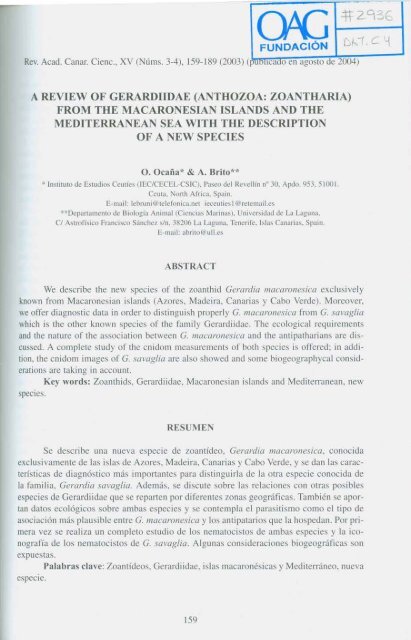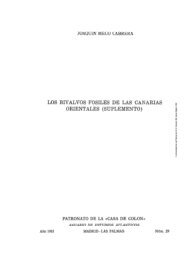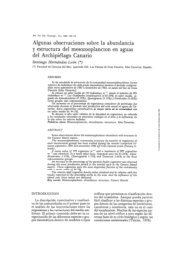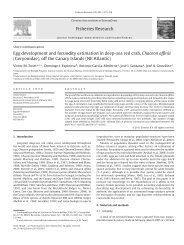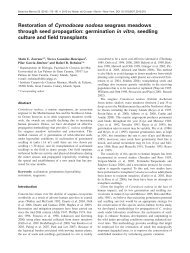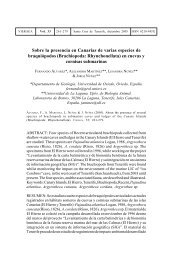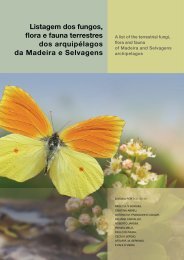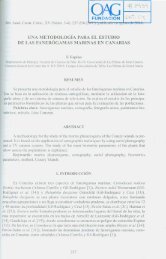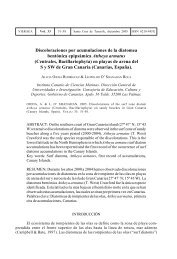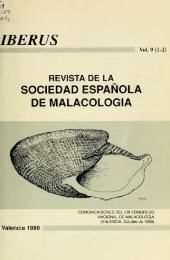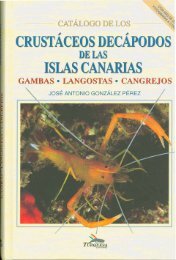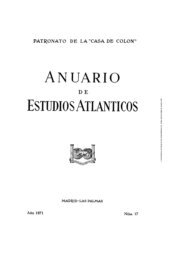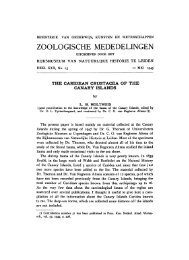A REVIEW OF GERARDIIDAE (ANTHOZOA: ZOANTHARIA ... - redmic
A REVIEW OF GERARDIIDAE (ANTHOZOA: ZOANTHARIA ... - redmic
A REVIEW OF GERARDIIDAE (ANTHOZOA: ZOANTHARIA ... - redmic
Create successful ePaper yourself
Turn your PDF publications into a flip-book with our unique Google optimized e-Paper software.
QAG<br />
FUNDACION<br />
A <strong>REVIEW</strong> <strong>OF</strong> <strong>GERARDIIDAE</strong> (<strong>ANTHOZOA</strong>: <strong>ZOANTHARIA</strong>)<br />
FROM THE MACARONESIAN ISLANDS AND THE<br />
MEDITERRANEAN SEA WITH THE DESCRIPTION<br />
<strong>OF</strong> A NEW SPECIES<br />
O. Ocaña* & A. Brito**<br />
* Instituto de Estudios Ceutíes (IECICECEL-CSIC), Paseo del Revellín n° 30. Apdo. 953, 51001.<br />
Ceuta, orth Africa, Spain.<br />
E-mail: lebruni@telefonica.net ieceulies I @retemail.es<br />
**Departamento de Biología Animal (Ciencias Marinas), Universidad de La Laguna.<br />
CI Astrofísica Francisco Sánchez sIn, 38206 La Laguna, Tenerife. Islas Canarias. Spain.<br />
E-mail: abrito@ull.es<br />
We describe the new species of the zoanthid Gerardia macaronesica exclusively<br />
known from Macaronesian islands (Azores, Madeira, Canarias y Cabo Verde). Moreover,<br />
we offer diagnostic data in order to distinguish properly G. macaronesica from G. savaglia<br />
which is the other known species of the family Gerardiidae. The ecological requirements<br />
and the nature of the association between G. macaronesica and the antipatharians are discussed.<br />
A complete study of the cnidom measurements of both species is offered; in addition,<br />
the cnidom images of G. savaglia are also showed and some biogeographycal considerations<br />
are taking in account.<br />
Key words: Zoanthids, Gerardiidae, Macaronesian islands and Mediten'anean, new<br />
species.<br />
Se describe una nueva especie de zoantídeo, Gerardia macaronesica, conocida<br />
exclusivamente de las islas de Azores, Madeira, Canarias y Cabo Verde, y se dan las características<br />
de diagnóstico más importantes para distinguirla de la otra especie conocida de<br />
la familia, Gerardia savaglia. Además, se discute sobre las relaciones con otras posibles<br />
especies de Gerardiidae que se reparten por diferentes zonas geográficas. También se aportan<br />
datos ecológicos sobre ambas especies y se contempla el parasitismo como el tipo de<br />
asociación más plausible entre G. macaronesica y los antipatarios que la hospedan. Por primera<br />
vez se realiza un completo estudio de los nematocistos de ambas especies y la iconografía<br />
de los nematocistos de G. savaglia. Algunas consideraciones biogeográficas son<br />
expuestas.<br />
Palabras clave: Zoantídeos, Gerardiidae, islas macaronésicas y Mediterráneo, nueva<br />
especie.
Recent studies of Gerardiidae have been carried out by several auth .'<br />
Canary Islands and others Macaranesian archipelagos. These authors recorde~rs I~<br />
speCles, Gerardia savaglia (=Savalia savaglia~ from the Canaries, Madeira an a SIn<br />
Verde (see BRITO, 1983 [1] Y 1985 [2]; OCANA el al., 1995 [25]). Unfortu d ea<br />
f G 1 "· M' '" nately<br />
presence o . savag La In acaraneslan waters was a mlsldentlfication motiva '<br />
l k f d<br />
'd 'f' . d' . . ted by .1._<br />
ac o goo I entl IcatlOn escnptors m the Ilterature (especialIy concern" "ti:<br />
savaglia)<br />
Gerardia<br />
and the similarities showed by both, G. savaglia and the present ne~g to<br />
macaronesica. As we pointed out previously (OCAÑA el al., 1995 [25?e c1<br />
many taxonomical problems of zoanthids are increased due to the absence of a . 1~4<br />
d<br />
.. f h . A' . . ppropn<br />
escnptlOns o t ese specles. new specles, G. macaroneslca, IS described; this<br />
ISWI "d esprea d' In thM' e acaroneslan IS . 1and s, from Azores to Cabo Verde being abs specl f<br />
' enl ro<br />
the Mediterranean.<br />
G. savaglia is a well known species (although not welI described) through !be<br />
Mediterranean Sea, which was recorded also from Madeira by JOHNSON (1899) [1<br />
named as Gerardia lamarckii. The presence of a protein skeleton was the reason arguedby<br />
Johnson to inelude it into the Antipatharian. CARLGREN (1895) [4] merged the speci<br />
into the Parazoanthidae family. This peculiar anatomical item (skeleton axis), unknown UI<br />
any other group of soft hexacorals, plays an important role in the biology of these speci<br />
and also supports the Gerardiidae family to be separated from the others (see OCAÑA etal<br />
1995) [25]. After this taxonomical papel', new material and information has been aehieved<br />
on both Gerardiidae, the Mediterranean and the Macaronesian species. There are enougb<br />
morphological similarities (colour, growth and size) between both species (G. savaglia and<br />
G. macaronesica) to think that there is only a single one. However, the autoeeology and<br />
some other characters<br />
both species.<br />
fram the anatomy and the cnidom make a elear differenee between<br />
The cnidom is one of the main characters in order to distinguish the speeies of<br />
anemones sensu lalo (see SCHMIDT, 1972 [30] & 1974 [31]; OCAÑA, 1994 [24]) and w<br />
demonstrate in this papel' that it is also important for taxonomical purposes in zoanthids<br />
Obviously, zoanthids needs more descriptive information in order to define properly !he<br />
species and the other taxonomical categories. Sensu SCHMIDT (1974 [31]: 544) Gerardl<br />
is merged into the recent Zoantharia in which are ineluded all the zoanthids with speeialbmastigophores<br />
(spirulae) in the column wall: Parazoanlhus Haddon & Schackleton, 1891<br />
Epizoanlhus Gray, 1867, Zoanlhus Lamarck, 1801 and Gerardia Lacaze-Duthiers, 1864<br />
However, there is not descriptive information to assure that this particular cnidom eharacter<br />
is present in alI the species above mentioned. One of the major prablems on zoanthids t~<br />
onomy is the absence of complete deseriptions in order to recognize properly ~hespecl~<br />
Despite some authors offer enough anatomical information in the specialized blbhograpth<br />
(structure and placement of the sphincters and disposition of the mesenteries, among ~<br />
ers), the cnidom characteristics were low considered and usualIy, not well valuatedRT<br />
CARLGREN, 1937 [5] y 1938 [6]; PAX, 1952 [26]). A more recent paper (HERBE'<br />
dOI1l<br />
1972 [13]) takes in account some cnidom categories, however, stilI it is needed more en! di<br />
information, images and measurements, together with the other characters, in arder to<br />
tinguish accurately the zoanthids species. ri¡,ed<br />
G. macaronesica is the second species which belongs to Gerardiidae and des~dYin<br />
worldwide. We offer a complete description of this species and also a comparatlve 51<br />
. . .h G macaronesica fram G. savaglia. In addition, some cnidom data of<br />
disunguIS .<br />
to.· described) fram the Indopacific and New Zealand are documented.<br />
'les (no . .<br />
r pe\; . d' (T to HÁUSSERMANN (2003) [12] the genus Savalta Nardo, 1844 has taxccor<br />
.<br />
In"<br />
. over Gerardia Lacaze-DuthJers,<br />
.<br />
18<br />
6<br />
4. However, due to the wlde<br />
.<br />
use of<br />
. -al pflofllY . f 1864 '11 d'd ...<br />
1Tl1\; d' I in the recent hterature, rom ti now, we eCI e to maIntam 11.<br />
S<br />
nU<br />
Gerar IC<br />
ge "<br />
'1lnensfrom the Can aries studied in the present work was collected by scuba<br />
The spec . ..<br />
sampling trips during ~h.eBen~os PraJect (Universidad de.La.Laguna, .1980.-1985) and<br />
I IDg d'l'ons and scient¡f1c praJects, headed by local mstltutlOns (Universidad de La<br />
oth r expe I I . .<br />
. Museo de Ciencias Naturales de Santa Cruz de Tenenfe), between 1985 and 1994.<br />
guna,. ale organizations which organize colIeting expeditions, as Farmamar Expedition<br />
OtherpflV .,.<br />
1990), also ha eontributed to co~lect mor~ speclmens of Gerardlldae along th~ .Canary<br />
Ilands. The material from Madelra Archlpelago belongs to the Museu MunicIpal do<br />
unchal(MMF) colIeetions. The material fram Cape Verde has been collected by scuba div-<br />
IDgduring several expeditions supported by different ins~ituti?ns fram the Canaries (Museo<br />
d Ciencias Naturales de Santa Cruz de Tenenfe; UniversIdad de Las Palmas de Gran<br />
anaria; Gobierno de Canarias). The sample fram Azores was sent by Universidade dos<br />
ores, Departamento de Oceanografia e Pescas (DOP).<br />
The material of G. savaglia was colIected in two different western Mediterranean<br />
I alities: Ceuta (Gibraltar Strait) and Banyuls (France). Other consulted specimens fram<br />
th Indopaeifie and New Zealand has been facilitated by the Copenhagen Zoological<br />
u eum (ZMUC) and the Auckland Museum (AK) in order to make comparison<br />
pecies.<br />
with our<br />
The holotype of Gerardia macaronesica is deposited in the Museo de Ciencias<br />
aturales de Santa Cruz de Tenerife (TFMC). The paratypes are deposited in the Museo de<br />
HI toria Natural de Madrid (MNCN), Museu Municipal do Funchal, Madeira (MMF) and<br />
ationaal Natuurhistorisch Museum, Leiden (RMNH). Some colonies and most of the histol~giealslides<br />
are also deposited in the colIection of the Departamento de Biología Animal,<br />
Diversidadde La Laguna, Tenerife (DZ ZG). Part of the material examined and also the<br />
pe~anenl enidom slides are deposited temporalIy in the private collection of O. Ocaña and<br />
11 wlll be senl to the apprapriate institutions, once the studies has been coneluded.<br />
Part of the material (specialIy the material from Canary Islands) were anaesthetized<br />
~<br />
nh<br />
re<br />
menlhol<br />
. .' .<br />
el'<br />
ys<br />
t<br />
a<br />
1<br />
s an<br />
d'<br />
preserved In 8% formaldehyde. As some colon les<br />
"<br />
come from dlfntlmslIlullOnsand<br />
prajects, most of them are fixed directly in alcohol not relaxing pre-<br />
10USy ¡he 1 T '<br />
di ' . p? yps. he general morphology and anatomy were studied by means of a stereo<br />
sectmg mlcro Th<br />
aJ'al h Scope. e anatomy and histology were studied following the Ramón y<br />
mel od for topo h' ..<br />
I J) S· grap ICstamIng. Mallory triple stain was also used (see GABE, 1968<br />
. peclmens of l .<br />
edit. . co onles fram Canary Islands and Cape Verde and also from the<br />
crranean w .<br />
and exa' ere sectlOned for histological purposes (more than 500 slides in a whole)<br />
Int rfere mmed and studied with a light micrascope equipped with Nomarski differential<br />
nee Contrast .<br />
nn gel lh Opllc system. Permanent slides of cnidom were prepared using glyc-<br />
, e same tech . -<br />
The el '. ~Ique prepared for meiofauna (see OCANA, 1994 [24]).<br />
I-IM1DT(1;;slflcatlOn and terminology of nematocysts used is essentially after<br />
2) [30], as adapted by den HARTOG el al. (1993) [11]. The surveys of the
cnidorn are surnrnarized in tables, in which the means and ranges of length and .<br />
nematocysts are included. A large collection of underwater irnages has been usedW1dth<br />
to show the color and shape variations, some aspects of its autoecology and als In o<br />
variety of environrnent where the new species may occurs. o the h¡<br />
Familia Gerardiidae Roche & Tixier-Durivault, 1951(=Savaliidae Nardo, 1844?)<br />
Género Gerardia Lacaze-Duthiers, 1864 (=Savalia Nardo, 1844)<br />
Savaglia larnarckí, JOHNSON, 1899 [15]: 814-815, short description, the species is iden<br />
fied with Gerardia savaglia (=Savalia savaglia) and merged into the Antipatharian Wt<br />
doubts; Madeira and the Mediterranean Sea.<br />
Gerardia savaglia, BRITO, 1983 [1]:89-91, figs. 1-3, autoecology and distribution; folio<br />
ing JOHNSON (1899) [15], the species is identified as G. savaglia; the Mediterranean,<br />
north Morocco, Canary Islands and Madeira. BRITO, 1985 [2]:178-183, fig. 35, lam. 3<br />
description, habitat and some ecological notes; colour images; Canary Islands, Madeira,<br />
Mediterranean and north Morocco. PÉREZ y MORENO, 1990 [27]: 81, a repetition<br />
some Brito's data, one colour image. OCAÑA et al., 1995 [25]:153-164, figs. 2-4, colour<br />
images, complete study of the anatomy, histology and cnidom, ecological notes; Can~<br />
Madeira and Cape Verde islands. WIRTZ, 1995 [32]: 52, exclusively a color image,<br />
Holotype: (TFMCBMCN/000188), colony (13 cm high and 13,5 cm wide) witb<br />
more than 1000 polyps growing on Tanacetípathes cavernicola Opresko (200la) branch<br />
almost all the axis of T cavernícola covered by the zoanthid, some calcareous sea weedsand<br />
barnacles were noticed on the branches too; O. Ocaña coll., 14-08-2002, Punta Preta.<br />
Tarrafal, (Santiago, Cape Verde Islands), 20 m, scuba diving, 15°1TN 23°46'0. paraty~<br />
(MNCN 2.04/1079), branch of the same colony (with 100-150 polyps and 13 cm high) w' H<br />
some areas of the antipatharian not covered by the zoanthid; same data as holotype; (RM !he<br />
Coe!. 32362), branch with 150-300 polyps and 23 cm high, with some areas of re<br />
. . . l' fE' tOléquata we<br />
antlpathanan not covered by the zoanthld, severa speclmens o UnLce . 0.200<br />
noticed living on the colony; same data as holotype; (MMF35616), branch wlth 10<br />
polyps and 10 cm high, calcareous debris noticed; same data as holotype,<br />
Other materials<br />
'O 24 [7.19 O<br />
Canary Islands: Tenerife: (DZ ZG-I) Las Caletillas, 28°21'N 16°21 , -. - thell<br />
, An/lpa<br />
75 m, by entangled in the fishermen nets and traps, small colony growmg on 1981.100<br />
wo/lastoní, G. Dionis leg.; (DZ ZG-2) Punta de Güímar, 28°l8'N 16°20'0, 14-03-<br />
f<br />
· h men nets and traps, small colony growing on Antipathella wollas-<br />
. thc IS er<br />
taJlgl~d~n c ; (TFMC CN/0151) Playa Santiago, 28°15'N 16°50'0, 1~~03-19.89, 25 m<br />
. D1on,.sI g'd" small colony growing on Antipathella wo.llastolU In vertIcal wall,<br />
'uba IVlllg,<br />
1 ¡ d h) se ZG-3) Punta Teno, 28°20'N 16°55'0, 15-09-1990,40 m collected by<br />
ana leg.; (OZ 1 nies growing on rock platforms and also on small specimens of<br />
. . , sl11allco o - 3) O O - I O h<br />
ba dI\1l1g.· . . colour images (see Ocana et al., 1995:16 , . cana ego t er<br />
I / / lI'o//a.\/OIlI, . PI S J<br />
palIe (/ d but not collected, on different areas of the Island: aya an uan<br />
'ere observe , . . I 25<br />
Imens \\ l owing on a dead axis of A. wollastoní placed In a vertIcal wal ,<br />
. t 's) co ony gr<br />
Glgan c.. Z ZG-4) Tazacorte, 28°21'N 16°21'0, 3-11-1990, 30 m collected by scuba<br />
, - D!llrna:<br />
~<br />
(O<br />
. s of a big colon y growmg<br />
..<br />
on vertlca<br />
l<br />
wa<br />
II<br />
,co<br />
l'<br />
or Images,<br />
O<br />
.<br />
O<br />
cana<br />
-<br />
, I11CspecIlnen.<br />
Ing. ~il;m;: (OZ ZG-5) Punta d~ los Frailes, 27°3~'N 1.8°00'0, 3-?~-1982" 23 m by<br />
EL l growing on Antlpathella wollastolU, Tallarte Expedltlon leg., (DZ ZGmall<br />
co ony . . .<br />
ge, s . F 'Ies 27038'N 18°00'0,07-1985,35-45 m, by scuba dlvlng, small portlon<br />
Puntade los ral ., ..<br />
lony groWI<br />
'ng on Antipathella wollastoní at the cave gate, A. Bnto leg, Gran Canana:<br />
a o 7 P rto de Sardina 28°08'N 15°42'0, 5-10-1983, 12 m, by scuba diving, small<br />
DZ ZG· ) ue, .<br />
. g on Antipathella wollastoní other colonies were observed growlng on walls,<br />
lonygrow1n ' , 0' 0'<br />
Brito leg.; (DZ ZG-8) Punta de la Sal (El ~abron).' 27 52 N 15 22 O, 6-0?-1990, 30 m,<br />
cuba diving, portion of a big colony growmg o~ ItS own skeleton, F. .Esplno leg, Oth~r<br />
cimens were observed, but not collected, on dlfferent areas of the Island: El Cabron<br />
nnaga). 10-20 big colonies growing on its own skeleton placed on a rocky platform wlth<br />
d (color images), 30-40 m, Lanzarote: (DZ ZG-9) Puerto del Carmen, 29°03'N ]3°32'0,<br />
1 1O-191U,40 m, portion from a big colon y growing on A. wollastoni and placed at the<br />
nuuncave gate, color image (see Brito, 1983 y 1985) T. Cruz leg.; (DZ ZG-IO) Puerto del<br />
armen. 29°03'N 13°32'0,22-06-1990, 55 rn collected by scuba diving, portion from a<br />
lony growing on A. wollastoní placed in a crevice in a vertical wall with L. pruvotí, O.<br />
aña leg. Many other specirnens were observed but not collected around the Montaña<br />
lara islet. Fuerteventura: (DZ ZG-ll) Frente a Casas de Jacomar, 28°16'N ]3°53'0,21-06-<br />
1990.35 m collected by scuba diving, portion from a big colony growing on A. wollastoní<br />
and placed in the middle of a small tunnel, O, Ocaña leg.<br />
Madeira: (MMF25715) Cais do Porto Novo (south Madeira coast), N 32° 39' 629"<br />
16°48' 390",13-04-1994,31 m collected by scuba diving, portion from a colony grow-<br />
IOg on A. \\'ol/astoni on its own skeleton, P. Wirtz leg.; (MMF27120) Antigo Cais do Porto<br />
ovo (south Madeira coast), N 32° 39' 779" W 16° 48' 224",<br />
b scuba diving, P, Wirtz leg.<br />
19-07-1997,47 m, collected<br />
lores: (DOP) Formigas Islets, 37° 16' 08"N 24° 46' 48"W, 25-08-2002, 25 m colted<br />
hy scuba diving, several portion of colonies growing on A. wollastoni, not well prerved<br />
material, F. Tempera leg.<br />
12 19 Cape Verde: Santiago: (DZ ZG-12) Caleta do Sao Martinho, 14°54N 23°34'0, 31-<br />
.,. K7, 17 m, collected by scuba diving portion of a big colony growing on<br />
lanU('('1 I '<br />
'/Hitles cavernícola, crevice in a vertical wall with many specimens of Euníce<br />
rquuta living o th I . . . ..<br />
Palmas'l '. . n e co ony, A. Bnto leg.; (C-16), (Matenal from UllIversldad de Las<br />
rowin ,ile prOJect to Cape Verde), no data, scuba diving collected, portion of a colony<br />
g On r ca . l' .<br />
v ral . .' verntco a, F. espmo leg, Other colollles were observed, but not collected:<br />
r (u\,('r"tes/ of the Tarrafal Bay, between 20 and 35 m, in shadow habitats, associated with<br />
nlCO a O O - I<br />
and Cav" " '. cana eg; King fish, 15°16'N 23°46'0, 25-40 m, vertical walls, tunnels<br />
"s, assoclat d . h<br />
47'0, 25.35 ~ Wlt T cavernicola, O. Ocaña leg,; Faro de Tarrafal, 15°1TN<br />
m, blg caves and tunnels with vertical walls, associated with T caverníco-
la, strong current environment, O. Ocaña leg. Sal: we observed colonies in Santa M .<br />
16°35'N 22°54'0, 20-25 m, on vertical waJls and crevices, associated with Tarta<br />
high sedimentation, O. Ocaña leg.; Palmeira Bay, 16°45'N 22°59'0<br />
gate caves, associated to antipatharian, O. Ocaña lego<br />
25 m ver·t·cavlernlc<br />
, , Ica w 1I<br />
a<br />
Morphology: Several ways of growth and external appearances can occu' h<br />
. r In t e<br />
ent new specles. In the case that the colony creates its own skeleton, a basal plate is P<br />
ated where the polyps are asexuaJly produced (Fig. 5e); after this the colon y Contin gen<br />
erating many branches in a single plane or in several of them. Sometimes the spe ~esg<br />
.. . c~<br />
ge~erate a poor developed ~Ibbon hke skele~on, ha:dly notlced without an aCCurateob<br />
vatlon of the colony. GroWIng up on an antlpathanan skeleton is the third way of<br />
showed by this new species, the characteristic spines of those are some identificatio~T0har.<br />
acters in order to distinguish the antipatharian skeleton where the G. rnacaronesica c<br />
occurs. The colonies may reach one meter high.<br />
In preserved material, the polyps measurements are variable between 0,2-1 cm hi<br />
and 0,2-0,5 wide; due to the retraction stage the column can be cylindrical to flat mamm¡.<br />
form; the texture should be roughly by the 90ncentration of sand in the ectoderm of<br />
polyp walJ. In aJive and expanded conditions the sizes increase considerably in two OTthree<br />
centimeters at least. Colonies with small polyps were frequently noticed in the material froII<br />
Cape Verde. The tentac1es present medium size in expanded conditions; they are pointed.<br />
42 in number, arranged in two, more or less, entacmeic cyc1es; we noticed 21 marginal t<br />
The polyps are overhanging from coenenchyme, but extremely embedded polyp<br />
noticed. Wide coenenchyme in the well developed areas with many polyps, fine and I<br />
developed in the extreme areas of the colony.<br />
The species present several colours, from yellow to orange in the tentacles, the<br />
coenenchyme and the column (Fig. 5). As a consequence of the sediment accumulation and<br />
other conditions, not well c1eared, the column can be brownish or whitish, or even pinki<br />
in the column; the brownish column are typical from the colo nies growing on antipathan<br />
ans, although not exclusively. Fixed specimens turned into red colour frequently allhou<br />
orange or brownish are also possible.<br />
Microanatomy and histology: The mesenteries present macrocnemic dispositio<br />
although one specimen showed an intermediate arrangement; there are 28 mesenleries iothe<br />
pharynx region and 42 in the upper column region. Most of the mesenteries are conoected<br />
with a short, low folded pharynx; a single siphonoglyph, larger than wider, is noticed (FI<br />
2d).<br />
The sphincter is well developed and mostly endodermal, aJthough a final portioOo<br />
.<br />
It ISconsldered<br />
. .<br />
mesogleal (see OCANA<br />
- . 5 b) The meseoler<br />
el al, 1995) [25] (see Flgs. a y . an<br />
ial musc1es are poorly developed, we failed in detecting retractor musc1es and weak ~ure<br />
l<br />
etobasilar musc1e only in some mesenteries. The tentacles present also a weak mus cu a<br />
and it is arranged in short process. 1 pre5<br />
The ectoderm present to 80 11mthick, being in the column poorly develo ped<br />
i :iSu<br />
ents glandular ceJls and b-mastigophores; there is afine cuticle that covers the who e '0 the<br />
. 'd tegones, l<br />
The tentacular ectoderm IS well developed and presents several cm om ca e cilia are<br />
pharynx we noticed a few nematocysts, absence of glandular cel1s and larg<br />
observed in the siphonoglyph.<br />
. can reach to 120 Ilffi thick; it presents afine structure and more develm<br />
'sog 1 oea . . .<br />
')1le (;. I than in other anatorrucal areas. We notlced low cel1ular denslty, some<br />
h' "0 umn<br />
110 1 (; ~ d I content have been observed (Fig. 2c); sand incrustations are numerous<br />
. h glan u ar<br />
\\11 art of the column. The mesogloea is hardly noticed in some areas of the<br />
. lhe outer p . .<br />
aaUy10 h harynx wider in the slphonoglyph than In any other area of the pharynx.<br />
nleries aod ld e . p can r~ach to 80 Ilffi thick, it is formed by absorption cells in the col-<br />
Th' codo elm .<br />
e l' dular cel1s among those; commonly, not folded and It presents a low<br />
d some g an .<br />
aO· Mt landular cells are observed along the mesentenes; a very low developlopmeol.<br />
dOd s rgmis noticed in some mesenterical areas. There are filaments unilobuf<br />
lhe en o e<br />
010 '1 h I led (Figs 2 e and f) in the top of the mesenterial filaments. In the speciaod<br />
In o u a· . .<br />
"d we observed gonads development In all the macrocnemes (FIgs. 2 g and h).<br />
o ludle, 'd ( . d l<br />
oidom: A complete survey of t~~ C~l om mea~urements, categones an p acef<br />
h 1alerial from different 10calJtJes IS presented In the table 1. We notlced one catnOolen<br />
. .<br />
of spirocysls and several cate~ones. of the other ~ematocysts eqUlpment: t~ree catery<br />
of elliplical, some of them oVOld,splrulae (b-~astlgophores); one category ISthe sp.eal<br />
pirulae only present in some groups of zoant~ld.s, as the presentogenus. T~ree pemcIlmasligophores)<br />
categones: one category of ellJptlcal to some oVOldpemcIlII A; one cat-<br />
~ of elliplical big penicilli E and other of rather small elliptical to ovoid penicilli E.<br />
lb re are al50 lWOcategories of real, but not very conspicuous, homotrichs of elliptical<br />
pe. a lhird liny category of nematocyst can be assume as a homotrich but it need confir-<br />
1100.<br />
Remarks.- The absence and the presence (or also the range of abundance) of some<br />
adomcalegories found in the studied material of G. rnacaronesica, along the distribution<br />
•should be explained as a part of the specific range of variation displayed by this taxon.<br />
rtheless, lhe different origins of the studied material and, specially, the differences of<br />
onservalion method used, should be also taking in account. Some tiny categories (as the<br />
mall homolrichs fram the wall) may be easily overlooked by the observer; moreover, the<br />
rang of abundance of these capsules categories, in the polyps from different colonies, does<br />
nol have lo be underestimated. Other categories which are not very conspicuous, like the<br />
medlUmsize homotrichs from the filament or pharynx, can be easily overJooked due to its<br />
n morphology and placement. We offer (see Fig. 1) an ideal nematocysts equipment for<br />
macarollesica, although, for identification matters we recommend to use the most common<br />
categories, always present in all the specimens from different populations studied by<br />
u ( e lable 1and Fig. 1).<br />
bit 1: G('/'{¡rdia lila. . .<br />
lJlary I lands COIoneSlca. Survey of the cmdom of five colonies from different localilies. A: El Hierro,<br />
Igas hlcls ¡DZZG-6). B: Santiago, Cabo Verde (DZZG-12). C: Holotype (TFMCBMCN/OOO 188). D:<br />
. lores (DOP n/n). E: Madeira (MMF25715)
-- Mean and range (in parentheses) Mean and range (in parentheses)<br />
Nematocyst<br />
Organ Origin<br />
type of length and with (lf Nematocyst<br />
N<br />
of length and with of N Frequency<br />
nematocyst capsules in /l<br />
FreqUen~<br />
orsall origin type<br />
---nematocyst<br />
capsules in /l<br />
D Spirulae (c) 13,9 (13-18) x 4,9 (4-7,5) 13 Homotrichs ? (j)<br />
8,9 x 1,1 1 Rare<br />
ComInon A<br />
E Spirulae (e) 17,4 (16-19) x 3,8 (3-4,5) 12<br />
COInInon Spirulae (m)<br />
19,2 (17,7-21) x 2,7 5 Rather common<br />
A<br />
E Spirulae (h) 17 x 2,5 ~rynl ---t- ¡.--<br />
1 Rare<br />
Soirulae (m)<br />
18,5 (15,5 22,2) x 3 (2,2 3,3) 11 Common<br />
B<br />
E Spirulae (c) ¡.--<br />
14,4 (13-16) x 5,3 (4,8-6) 18 ComInon<br />
Spirulae (m) 16 (15-18) x 3 (2,5 3,8) 6 Rather-common<br />
e<br />
A 1---<br />
Penicilli E (a) 24,2 (22,8-25,5) x 10 2<br />
Uncomrnon<br />
Soirulae (m) 16,9 (15-20,5) x 3 (2,5-3,5) 10 Common<br />
O<br />
A Penicilli E (b) 19,1 (18,9-19,4) x 7,1 (6,4-7,8) 2 Uncomrnon<br />
Spirulae (m) 18,6 (15-21) x 3 (2,8-3) 7 Rather-common<br />
E<br />
B Penicilli E (a) 24,4 (23,3-26,6) x 10,4 (9,4-11,1) 5 Uncomrnon<br />
Penicilli A (o) 14,4 x 4,4 1 Rare<br />
A<br />
t-<br />
B PeniciLJi E (b) 13,6 (13,3-14,4) x 6,8 (6,1-7,2) 4 Uncommon<br />
Penicilli A (o) 15,1 (13,3-16,7) x 3,7 (3,1-5,3) 5 Uncommon<br />
B<br />
C Penicilli E (a) 23 (21-25) x 9,3 (9-10) 4 Uncomrnon e Penicilli A (o) 15,1 (14-16) x 3,9 (3,5-4) 7 Rather-common<br />
C Penicilli E (b) I1 (10-12) x 5,8 (5,5-6) 3 Uncornrnon E Penicilli A (o) 19 x 4,8 1 Uncommon<br />
O Penicilli E (b) 15,8 (14-17,5) x 6,1 (5-8) 9 Uncornrnon A PeniciLJi E (q) 25 (22,2-27,8) x 10,5 (10-11,1) 2 Rare<br />
E Penicilli E (b) 14,4 (11,5-17) x 5,3 (5-7,5) 13 Common A Penicilli E (p) 15,3 (13,3-16,7) x 6,8 (6,1-7,8) 15 Common<br />
C Penicilli A (d) 14,5 (14-15) x 4,5 (4-5) 2 Rare B Penicilli E (q) 25,3 (31,1-27,8) x 9,8 (9,4-12,2) 13 Common<br />
O Penicilli A (d) 16,5 x 4 1 Rare e PeniciLJi E (p) 13,4 (12-17) x 6,7 (5,5-8) 21 Very common<br />
E Penicilli A (d) 19 x 4 1 Rare C Penicilli E (q) 24,3 (23-26) x 9,4 (8,5-10) 9 Rather-common<br />
C Homotrichs (n) 9,5 (9-10) x 3,2 (2,8-3,5) 2 Rare O Penicilli E (o) 14,9 (13-17) x 5,6 (4-7) 18 Very common<br />
D Homotrichs (f) 10,6 (10-11) x 3,3 (3-4) 6 Uncommon O Penicilli E (q) 26 x 8 I Rare<br />
Tentacles A Spirocysts (i) (11,1-22,2) x (2,2-4,4) 10 Very common E Penicill i E (p) 13,5 (13-15) x 6,6 (5,5-7) 16 Common<br />
B Spirocysts (i) (11,1-17,8) x (2,2-3,3) 10 Very common E Penicilli E (q) 26 (25-27) x 11,7 (11-12) 3 Rather-common<br />
D Spirocysts (i) 16,7 (10-25) x 2,5 (2-3) 3 Very common B Homotrichs (n) 9,8 (7,8-12,2) x 1,3 (1,1-2,2) 11 Common<br />
E Spirocysts (i) 20 (15-25) x 3 (2-4) 2 Very common C Homotrichs (n) 13,6 (12-15) x 2,7 (2,5-3) 5 Uncommon<br />
A Spi rulae (g) 17,6 (14,4-20) x 3,9 (2,8-4,4) 20 Common O Homotrichs (n) 17,8 (17-19) x 3,5 (3-4) 6 Uncommon<br />
B Spirulae (g) 16,6 (14,4-18,9) x 3,3 (2,2-4,4) 20 Common E Homotrichs ? (i) 9,5 (9-10)x2 2 Common<br />
C Spirulae (g) 17,1 (16-19) x 3,9 (3,5-4,8) 26 Very common E Homotrichs (n) 14 x 2,8 1 Uncommon<br />
C Spirulae (h) 16 (15-17) x 2,3 (2-2,5) 2 Uncommon FlIaments C Spirulae (r) 16,1 (15-17) x 3,5 (3-4) 7 Uncommon<br />
D Soirulae (h) 16,5 (16-17) x 2,5 2 Rather-commCII A Penicilli A (v) 16,5 (14,4-18,9) x 4,9 (3,96,7) 22 Common<br />
D Spirulae (g) 16,7 (15,5-18) x 3,9 (3,5-4,5) 8 Common B Penicilli A (v) 16,3 (14,4-18,9) x 4,9 (4,2-7,8) 21 Very common<br />
E Spirulae (g) 17,5 (15-19) x 3,8 (3-4,5) 19 Very commo!!,.. C Penicilli A (v) 14,9 (13 16) x 4,2 (3,55) 15 Common<br />
E Spirulae (h) 16,6 (12- 18) x 2,3 (1,8-3) 11 Rather-com~ O Penicilli A (v) 17,2 (15-20) x 4,3 (3,5-5) 12 Very common<br />
A Penicilli A (k) 17,8 (14,4-20) x 4,7 (3,7 4,4) 3 Rare - E Penicilli A (v) 15,3 (14 19) x 4,5 (3,8-5) 12 Very common<br />
B Penicilli A (k) 16,7 x 4,4 1 Rare - A Penicilli E (w) 24,2 (18,927,8) x 9,4 (6,7-10) 6 Uncommon<br />
C Penicilli A (k) 14 (12 15) x 4 3 Uncomm~ A Penicilli E (u) 17,5 (13,3-18,9) x 7 (5,6-8,7) 30 Very common<br />
D Penicilli A (k) 17 x 3,9 (3,8-4) 2 Uncomm~ B Penicilli E (w) 25 (24,4 25,5) x 11 (10,9 11, 1) 2 Rare<br />
E Penicilli A (k) 17,8 (16-19) x 4,3 (3 5,5) 5 Uncom~ f..--B PeniciLJi E (u) 14,5 (12,2 16,7) x 5,9 (5,5-7,2) 20 Common<br />
12 Comm~<br />
C<br />
A Penicilli E (1) 15 (13,3 16,7) x 6,7 (5,6-7,5)<br />
Penicilli E (w)<br />
Rare ___<br />
21,9 (20 26) x 9,6 (8,5-10) 17 Common<br />
I-----C<br />
B Penicilli E (a) 23,9 (22,2-25,5) x 10 2<br />
Penicilli E (u) 13,2 (11-15) x 5,8 (5 7) 17 Very common<br />
1----0<br />
B Penicilli E (1) 14,9 (13,3-16,7) x 6,5 (3,9-7,8) 25 Co~<br />
co~11<br />
Penicilli E (u) 15 (14-16) x 5,5 (5 6) r-----9<br />
12 Very common<br />
C Penicilli E (l) 13,3 (11-15) x 6,6 (6 7) 15 Com~<br />
PeniciLJi E (w)<br />
r------L<br />
24,5 (24 25) x 11,8 (11,5 12) 2 Uncommon<br />
D Penicilli E (1) 15 (12,5-17) x 5,9 (5-7) 25 Penicilli E (w) 25 x lO 1 Rare<br />
16<br />
Common<br />
E<br />
PeniciLJi E (u)<br />
E Penicilli E (1) 13,1 (12-15) x 6,2 (5-7) 14,5 (13 18) x 6,4 (6 7,5) 16 Very common
Organ IOrigin I<br />
Nematocyst<br />
type<br />
Mean and range (in parentheses)<br />
of length and with of IN<br />
nematocyst capsules in /l<br />
Ecology<br />
A Homolrichs (I)? 9,2 (7,8-10) x 1,7 (1,4-2) 3<br />
B Homotrichs (I)? 9,6 (7,8-12,2) x 1,8 (1,1-2,8) 17<br />
e Homolrichs (s) 12,3 (11-13) x 3,3 (2,5-4) 4<br />
o Homotrichs (s) 15 x 2,8 1<br />
o Homolrichs (I)? 8,3 (8-9) x 2 3<br />
E Homolrichs (s) 13,4 (12-15) x 2,3 (2-2,5) 6<br />
E Homolrichs (I)? 8,7 (8-10) x 2,1 (1,8-2,5) 6<br />
Gerardia macaronesica is a typical species from circalittoral and deep infrali<br />
bottoms that often occur on Antipathella wollastoni, forming a very interesting associatil<br />
This association is very characteristic around the Macaronesian islands, except in<br />
Verde, where the zoanthids occur mostly on the antipatharian Tanacetipathes cavernicola.<br />
has been collected from 12 (only in some special habitats) to 100 meters deep, althoughv,<br />
little is known about its abundance in deeper bottoms. G. macaronesica is able to show<br />
eral ecological adaptation forms, but on infralitora! bottoms always is placed in dark<br />
tats, as vertical walls, cave gates, ruffs and big crevices, and in other habitats with the Ii;<br />
conditions diminished. Big colonies with their own skeleton have been noticed at some<br />
cial environments, where they find the ecological conditions to do it (this on!y has<br />
observed in scarce sites at Canary Islands). These environments seem to be exposed pl<br />
with high water movement. This is a key factor in order to understand the ecological di<br />
bution of this species. We find the most important concentration of G. macaronesica<br />
ing on its own skeleton in flat rocky and moderate sandy bottoms (Fig. 8a), but also in VI<br />
tical walls at the exposed islets (Fig. 8b), both habitats with high water movements. '<br />
morphology of the colonies and branches orientation can be quite different from one col,<br />
to another, being more related to water movements than any other factor. In the ex<br />
islets in Canary Islands (Montaña Clara, norte de Lanzarote) G. macaronesica was obse.<br />
together with the gorgonian Paramuricea grayii and a species of the genus Eunicel/a suD<br />
be identified. In deep infralitoral and circalitora! bottoms, and with different environ ,<br />
conditions, the zoanthid can also form rather neglected or not very conspicuou~ pOPula:..<br />
growing on walls and crevices (also exclusively noticed at Canary Islands), wlth very<br />
skeleton development (OCAÑA et al., 1995) [25], like fine axis hardly noticed froro<br />
wall (Fig. 9b). In this habitat the polyp's density is lower than in the other, but the zoan<br />
can cover a big piece of the substrate (Fig. 9a). . tatI<br />
The species grow on antipatarian on many occasions; some parts of the anl1P~~<br />
coenenchyme are damaged and destroyed by the zoanthid. It seems to be a case o it .<br />
sltlsm, . . where the zoant h'd I IS . growmg . on th e antlpatanan .. coenenc hy, me covenng . skc<br />
including alive parts inside the colenteron. The final result is to get the antipat~nanofSUI<br />
ton as an axis where grow up. Still, have to be studied if there is some absorptJOnlauSi<br />
stances that may bring some trophy benefits to the zoanthid, but it should be a ~nes"<br />
option to take it in account. Having demonstrated the serious damages that G.maca<br />
.. lharians, we think that the inquilinism (see MORTON, 1989) [21] can<br />
lhe:anllp
G. macaronesica is exc1usively known from the Macaronesian archi I<br />
deira, Canary Islands, Cape Verde and Azores). In Canary Islands is well kn pe a~os (<br />
islands and some inlets. OWnIn a11<br />
Gorgonia savaglia Bertoloni, 1819.<br />
Gerardia lamarckii LACAZE-DUTHIERS, 1864 [16]: 169, genus description. LAC<br />
DUTHIERS, 1865 [17]: 1-63, comparison with several speci~s of Antipatharians, no pl<br />
LACAZE-DUTHIERS,<br />
·<br />
ay: d tae.<br />
1882 [18]: 10-17, 1 planche, descnptlün of the parasitic Lauro<br />
~<br />
Gerardia savaglia, CARLGREN, 1895 [4]: 319-334, remarks the position into zoan<br />
and placed the species into Parazoanthiídae. ROCHE ET TIXIER-DURIVAULT, 1951[<br />
402-409, plate 1, external description, anatomy (mesenterial cyc1es), bioquimical chara<br />
of the axis, merged into the Gerardiidae family. ROSSI, 1958 [29]: 1-7, figs. 1<br />
Gerardiidae, some external characters, autoecology; Mediterranean (Egean Sea, Actri<br />
Argelia, Genova Gulf). LAUBIER & THEODOR, 1967 [19]: 223-225, fig.l, Gerardii<br />
some data of external anatomy and habitat, repetitíon of the Rossi's data, Banyuls -Sur-<br />
HERBERTS, 1972 [13]: 72, 142 Y 144, cited only in the key, merged into Parazoanthii<br />
Schmidt, 1974 [31]: 544, recent zoanthids. MANUEL, 1981 [20]: 78, merged<br />
Parazoanthiidae. ZIBROWIUS, 1985 [33]: 349-352, on the associated species Balssia~<br />
GILI et al., 1987 [9]: 13-17, short description, autoecology, comparative table, Catalo<br />
coas!. CALVÍN, 1995 [3]: 307, short description and some data about the habitat, ca<br />
image of a colony with possibly its own skeleton, the Mediterranean.<br />
Savalia savaglia, HÁUSSERMANN, 2003 [12]: 505, 1 abb., short description, and col<br />
picture, merged into the family Savaliidae Nardo, 1844.<br />
Ceuta: (Priv. Col.) Ciclón de fuera, North Bay, 35°54'N 5°17'0, 10_05-1998.30<br />
by scuba diving collecting, small piece of a big colony growing on its own skel elO ° tfi<br />
Haussermann, 2003: 505 for color picture of this particular colony), rock and sand pla<br />
near a vertical wall colonized by Paramuricea cLavata "forest", other small colon~;oS<br />
observed growing on P cLavata, O. Ocaña leg., (Priv. Col.). Sarchal, South Bay, 11col<br />
SOI7'O, 15-01-2004,30-35 m, by scuba diving collecting, some branches of a sm~ f(1l<br />
growing on P cLavata, community of several gorgonians growing on a rocky plal ole~t,<br />
specimen of the crustacean Balssia gasti living on the branches, copepodaoin ~ut~o~'E<br />
Ocaña leg. France: (ZMUC, no collection number) Banyusl Sur Mer, 42 ?9 N p da<br />
08-1968,40 m, by scuba diving collecting, small piece of a colony growlOg on .<br />
F. Fabricius lego<br />
. ferial ofller species examined<br />
rtlllve ",a<br />
Gt<br />
,.<br />
ran f(/<br />
° I l'<br />
"P' New Zealand: (AK 82153) Bay of Islands, Motuterakihi Te Pahi<br />
., ., . .. '<br />
174°05.8'E, 23 m, by scuba dlVlllg collectIng, smal1 colony possibly growd<br />
i; lo~~nskeJeton, smooth rac~ dome. with san?-silt s.kirt, A. ~. Stephenson leg.<br />
o 'fíc' (X-489 , ZMUC), zoanthld groWlllg on antlpathanan, medlUm size colony, no<br />
p el.. (Z_9695/KAH-9901l59, ZMUC), zoanthid growing on its own skeleton or on<br />
dala. :'Ig colony no more data; (TZ-61, ZMUC), zoanthid growing on its own skeleoacea.<br />
" '<br />
~ 00 gorgonacea, medium size colony collected by scuba diving.<br />
"0 i.~(for a more accurate description see LACAZE-DUTHIERS, 1864 [16]; ROCHE<br />
TI IER_DUR1VAULT,1951 [28]).<br />
The species is known to occur grawing on the gorgonian Paramuricea cLavata or<br />
o wilh ils own skeleton. When the species generates its own skeleton, as happen with G.<br />
amnel'ic(/ above described, a basal plate is generated where the polyps are asexually<br />
u ed unlillhe colony is generated with many branches in a single plane or in several of<br />
m<br />
In prescrved material, the size of the polyps varies between 0,1-0,6 cm high and 0,2m<br />
wide. The column can be cylindrical to flat mammiform if the specimen is strangly<br />
cled: ~exlur~roughly due to the co~centration of sand in the ectoderm of the polyp wall.<br />
lum Slze pOll1tedtentac1es, to 27 III number, arranged in two, more or less, entacmeic<br />
I : we nOliced between 13-18 marginal teeth (sometimes<br />
ooticed propcrly).<br />
those marginal teeth can not<br />
Pol~ps are overhangi~g fram coenenchyme, but extremely embedded polyps are<br />
d. W.ldccoenenchyme In the well developed<br />
loped 111Ihe extreme areas of the colony.<br />
areas with many polyps, fine and less<br />
The species present several colours, fram yellow to orange in the tentacles<br />
o nch~mc and column. We only detected pale yellow colonies (see Fig. 10). When fixed<br />
fonnahne, Ihe colonies turn to red colour.<br />
Internal "6 anatomy . and microanato my. . M acracnemlc. d' ISposltlün .. of the mesenteries<br />
rer~: - -2 8m.esent~nes. Pharynx short and not specially folded a single siphonoglyph<br />
an WIdcr ISnotlced (Fig. 4b).<br />
The sphincler is e d d 1<br />
pecimen' I . d n? ~rma and not well developed, it seems to be weak (at least in<br />
11 coversshaelsfte )h<br />
f andd¡ffIcult to be distinguished fram the rest of the endodermal mus-<br />
Weakand<br />
. ,<br />
t<br />
o<br />
b<br />
t e colum<br />
n more or<br />
l'<br />
ess (FIg. 4a). Retractors and parietobasilar mus-<br />
are arrang<br />
no<br />
d .<br />
o served praperl<br />
y.<br />
Th<br />
e<br />
t<br />
entac<br />
I<br />
es present also a weak musculature and<br />
T e 111short process.<br />
he ectoderm can reach 75 h' k .<br />
111 the phary . f..IID t lC In the column and 100 f..Imthick in the tentab<br />
nx we noltced a few b<br />
o erved in th . h nematocysts, a sence of glandular cells and large cilia<br />
k. present a re Slp onoglyph. The mesogloea of the column wall can reach to 125 f..Im<br />
ar lile structure and di'<br />
as. Wc notic d I more eve opment In the column than in other anatomib<br />
rved: some sa<br />
e<br />
d<br />
ow<br />
.<br />
cellular d<br />
ensIty,<br />
. b<br />
ut<br />
I<br />
acunae wlth<br />
.<br />
glandular content are frequent-<br />
Ode . n Incrustatio ..<br />
rm. Thc meso l' ns were notlced In the outer part of the tissue c10se to the<br />
Wld'<br />
er In the siph<br />
g oea IS hardly<br />
no<br />
f<br />
Ice<br />
d'<br />
In some areas of the mesenteries and<br />
'<br />
the pharmeSogloeaof<br />
the onloglYPhthan in any other area of the pharynx. In the inner face of<br />
al ti co umn it has b .<br />
Ssucand also big ho~ . een notlced a system of big lacunae like, with endootnchs<br />
(Figs. 4d, e and f). These areas are common along the
column wall; the endoderm associated to them can reach to 120 J.lm thick. W,<br />
observed unilobulated filaments. All the macrocnemes bear gonads in the s e Only<br />
ied (Fig. 4c). pec1rnen<br />
Cnidom: A complete survey of the cnidom (measurements catego'<br />
. . . , ' nes a d<br />
ment) of the matenal from the two Medlterranean 10calItIes studied is in Tabl n pl<br />
Fig, 3), We noticed one category of spirocysts and several categories of the e<br />
II<br />
(see<br />
. h . f 11' , oth cysts eqUlpment: t ree categones o e Iptlcal, so me of them ovoid<br />
el'<br />
.<br />
ne<br />
mastigophores); one category is the special spirulae only present in some g~Osplrulae<br />
th'd I S as the present genus. T'wo pemcI '11' I ( p-mastlgophores) . categories: one cate ups of<br />
tlca<br />
. l<br />
to some OVOI<br />
'd'<br />
pemcI<br />
'11'A d . gorYofel<br />
1 an one category of ellIptical big penicilli E es .<br />
mon In<br />
'h<br />
t especia<br />
' 1<br />
areas o<br />
f<br />
t<br />
h<br />
e en<br />
d<br />
oderm of the wall (see description above),<br />
peclally Co<br />
Table n. Gerardia savaglia. Survey of the cnidom of Iwo colonies from different Mediterranean I .<br />
Ceuta (North Africa) (Priv. Col.). B: Banyuls (France) (ZMUNI n/n) ocahu<br />
Colurnn A<br />
A<br />
B<br />
A<br />
A<br />
B<br />
Tentacles A<br />
B<br />
A<br />
A<br />
B<br />
B<br />
A<br />
B<br />
A<br />
Pharynx A<br />
B<br />
A<br />
Filarnents A<br />
Ecology<br />
B<br />
Nernatocyst<br />
type<br />
Spirulae (e)<br />
S irulae (d)<br />
S irulae (e)<br />
Penieilli A (b)<br />
Penieilli E (a)<br />
Penieilli E (a)<br />
S iroe sts (e)<br />
S iroe sts (e)<br />
S irulae (h)<br />
S irulae ( )<br />
S irulae (h)<br />
S irulae (o)<br />
Penieilli A (f)<br />
Penieilli A (f)<br />
Penieilli E<br />
.)<br />
Penieilli A (k)<br />
Penieilli A (k)<br />
Mean and range (in parentheses)<br />
of length and with of N<br />
nernatocyst capsules in 11<br />
15,6 (13-20) x 12,4 (10-15)<br />
16 x 2<br />
13,1 (9-16) x 10,6 (9-12)<br />
16,5 (13-20) x 4 (3-5)<br />
18,5 (14-21) x 9,3 (8-11)<br />
18,2 (16-20) x 9,1 (8,5-10)<br />
20 (15-25) x 2,8 (2-3,5)<br />
20 (15-25) x 2,8 (2-3,5)<br />
18 (16-20) x 3 (2,5-4)<br />
22 (20-27) x 4,8 (4-5,5)<br />
17,8 (16-23) x 3,3 (2,8-4)<br />
24,4 (22-27) x 4,5 (4-5)<br />
19,2 (15-23) x 4,4 (4-5)<br />
18 x 4<br />
26 x 10<br />
16,6 (13-20) x 3,2 (2,5-4)<br />
14,2 (12-16) x 4,3 (3,5-5)<br />
17 (15-19) x 4,8 (4-5,5)<br />
l3,6 (12-15) x 4,5 (3,5-5)<br />
14,2 (12-16) x 4,3 (3,5-5)<br />
5 Uneommon<br />
1 Rare<br />
10 Uneommon<br />
51<br />
20<br />
2 Rare<br />
2<br />
2<br />
28<br />
4 Uneommon<br />
23<br />
12<br />
II Uncommon<br />
1 Rare<br />
1 Rare<br />
37 Rather-co<br />
11 Rather-com<br />
2 Rare<br />
14 Common 13 Comm on<br />
G. savaglia is a typical species from circalittoral bottoms (see ZIBROWI.U~~:,9<br />
, , d to PO/OII<br />
[33]; GIL! et al., 1987 [9]; CALVIN, 1995 [3]) frequently found aSSOCIate . ¡"on WI<br />
clavata, In the Strait of Gibraltar area the species commonly occurs in asSOC1aI<br />
_ rsonal observation). Although other species of gorgonians has been<br />
O<br />
Ocana, pe .<br />
'(l (. .' to the zoanthids (see ROCHE et TIXIER-DURIVAULT, 1951[28]),<br />
. asS'lctatlOn "k 1 (F' 10)' h' b 1<br />
10 ' ' olonies growing wlth ItS own s e eton Ig. , In t IS case a asa<br />
1, 'cd sOme c . .) h l' . .<br />
no Il . del' to erect the colony (see dIagnosIs; ot el' co omes growIng on ItS<br />
'['Itcd In 01' ,<br />
gent: ' ecorded in the literature (ROSSI, 1958 [29]). In the case the specles<br />
I<br />
n has been l' " "<br />
10 / t l't is noticed some expanslOn of the zoanthlds, USIng ItS own skele-<br />
P e al'a a, , .<br />
Ing on , . (. h ppen al so with G. macaronesica) only generate ItS skeleton In so me<br />
G rtw/w,¡s a "'1 h<br />
a" . nian do not offer the appropnate support; a Slml al' p enomenon was<br />
h<br />
. thc gOlgo ,<br />
ert: , '1 by ROCHE et TIXIER-DURIVAULT (1951 [28]: 405). We always fInd<br />
d prcVIOUSY ., ,<br />
, h'lbitats with high blOdlverslty patterns and constant water movement,<br />
In some , ,<br />
I .' t be toa strong' locally G, savaglia colomes have been always observed<br />
h II can no '<br />
g 'Ians "forest" 01' very close to those. The common occurrence of G. savaglia<br />
the gorgon .<br />
. P clavata it seems to be, accordmg to ROCHE et TIXIER-DURIVAULT<br />
gorgol1lan ' "<br />
I 1281l, a similar parasitic phenomenon also observed In G. macaroneSlca on<br />
tharian species, .<br />
pa G. s(Jl'lIg/ia is a planctonic captor, able to prey on several specles of copepods as we<br />
d resl 01'these (partially digested) inside the coelenteron as a gut contento We find also<br />
d apod Ba/ssia gasti in association with one of the colony (for more information about<br />
ZIBROWIUS, 1985 [33]).<br />
sexual reproduction has been noticed by budding in several polyps following a simpallems<br />
find in G. macaronesica. We find gonads development in the specimens studn<br />
May and August, but specimens analyzed on January do not present any gonads what<br />
n islenl with the Mediterranean environmental conditions.<br />
G. sal'ag/ia it seems to be a species rather known in the western Mediterranean<br />
talonian coast, Baleares, Algerian coast, Naples and Geneva Gulfs and the Strait of<br />
braltar) including the Adriatic Sea and apparently less common in the Levantin basin<br />
re has hcen exclusively recorded from Aegean Sea,<br />
Gerardia mac " .<br />
rn the M, .aroneslca IS consldered here as a endemic element, exclusively known<br />
acaroneslan t Th' ,<br />
hlpelag(). . wa ers. e presence of thls taxon along the whole Macaroneslan<br />
s and the c' .<br />
thids is h oexlstence wlth the endemic antipatharians, where frequently the<br />
Olhcr cOsted,.support the later hypothesis.<br />
anog y Ocañ~d~~lc Macaronesian anthozoan, as the Actiniaria Actinia nigropunctata den<br />
rnatic events' 03, has been recently described, although in those cases, the Pleistocene<br />
. seems to pl '<br />
nce of end'<br />
emlc sp .<br />
ay<br />
.<br />
an Important role and was used by some authors to justify<br />
_<br />
the<br />
eCles In macaronesian waters (see den HARTOG & OCANA, 2003
[10]). We should consider this hypothesis: G. macaronesica was generated as a e<br />
of the Pleistocene isolation suffered by Macaronesian waters fram Africa coast ~nseq<br />
ference of these Pleistocene species, there is not consistent praves about the' ~t~<br />
macaronesica during the Pleistocene periodo Attending to the current Macaroo ng . 1ll<br />
graphical and ecological distributions of the zoanthid, it seems more plausibly t~eSI~<br />
ed before the glacial period and could survive to those fluctuant climatologic ~t tl e<br />
circalittoral or upper bathyal bottoms. The actual presence ofthe zoanthid in the ~ ang<br />
and, especially, in the Azores support the latter hypothesis of having survivar<br />
Pleistocene times. According to HOEK (1987) [14], the climatic perturbations e d<br />
bring the.destruction of most of littoral species fram the Azores in opposition toC~:ld<br />
accepted Idea (see MORTON et al., 1998 [22]); some new records of Actiniaria from<br />
(Ocaña et al. in prep.) support the latter idea. The high ecological possibilities of G<br />
aronesica are consistent with this assertion and invite to think about that particular id<br />
The abundance of G. macaronesica in Cape Verde call to explore the POSsibili~<br />
zoanthids as a Guinean element than could reach the Macaronesian archipelagos, th<br />
the warm periods suffered during the Pleistocene. If we assume the last argument, it WIU<br />
no rare that the species could even occur on other similar habitat from close related p<br />
as some spots of the Mauritanian, Senegal coasts and also at Guinea Gulf, extending its<br />
tributional range. Following the same argument, it can be also possible that G. savaglia<br />
be a relict Guinean species that could support the cold periods inside the Mediterranean.<br />
similar phenomenon is well known in some species of fishes such us the pomacen<br />
Chromis chromis (Lusitanic-Mediterranean) and Chromis limbata (Macaronesic-Guin<br />
(EDWARDS, 1986 [7]). G. macaronesica can occur apparently very little (at least in the<br />
ical habitats available with scuba diving equipment) in the Azores than in the other i I<br />
graup, this remarks the northern distributionallimit of this taxon. The occurrence of G.<br />
aronesica in association with Antipathella wollastoni remarks this antipatharian to be<br />
most common macaronesian host-substrate. Regarding this assertion there are not m<br />
possibilities to find G. macaronesica further north than the Azores.<br />
G. macaronesica is a new species of Gerardiidae and it constitutes the second s<br />
of such family described worldwide, being G. savaglia the first species which belon<br />
such family, which has been already described. The great shape sirnilaritYand other anaI<br />
ical characters between both species of Gerardia studied in the present paper and ~he<br />
of appropriate description of the G. savaglia in the literature gets us into the conf~slon,<br />
.. . . M . . 1 t n (see OCANA el<br />
we faIled III recogOlzlllg our acaroneslan maten a as a new axo . f<br />
1995 [25]). Fortunately, the intuition of Dr. Zibrowius (com. in litt.) put us Lllalert o<br />
affair as he always felt they were different taxa. Th s<br />
G. macaronesica and G. savaglia present dlfferent<br />
.<br />
cnl<br />
'd<br />
om eqUlpm<br />
. ents<br />
.<br />
e. "0<br />
. . . h'l G savagl G. macaronesica presents a hlgh number of cnldom categones, meanw le· f eniciJli<br />
ent less cnidom categories, being less armed in a general sense. The absence °f Ph<br />
. . f h f ues o t e<br />
(p-mastigop~ores and even holotr~chs by.other authors! III most o ~ e ISs different<br />
ies<br />
G. savaglia IS one of the malll cnldom dlfferences whlch makes thlS spec G sava<br />
. . . d·ft s from ..<br />
G. macaronesica (see Figs. 1 and 3). In addltlon, G. macaroneslca 1 er. hore<br />
in having common elliptical capsules of special spirulae (special b-mastJg~p presen<br />
SCHMIDT, 1974 [31]) in the body wall (see Fig. 1) meanwhile G. savag ¡a<br />
of special spirulae (see Fig. 3). There are also some minor, but conaree<br />
eutegory the cnidom morphological categories and others, this differences<br />
difli re 'es umong f h 'd h h h' (<br />
nc ., urements and placement o t e COI om t raug t e tlssues see<br />
. h the meas<br />
lId Wlt . t are specially concentrated in the tentacles, although they are also<br />
11) Splrocys s . .<br />
I aod . ,1 h tissues, being very common III the pharynx and the fllaments of<br />
'hout al te.. . h . h<br />
Ihroug . 'd"d e We find also some small, other tlllY, IllCOnSplcuoUS omotnc s<br />
. )1 Gerar 11 a . . . d'ff<br />
peeles 1 • eSI'ca not found in G. savaglia. Some shght cnldom I erences<br />
. G macmon . . .<br />
n 10. . T bleI) from different 10calItles has to be archlved as a part of the<br />
. I mIes (see a . .<br />
o co 1 f' h 'pecies thraugh the Macaronesian waters. Part of these cmdom dlfrunge<br />
o t e s .. . Id<br />
uoo 1 due to the fixed methodology applJed to the maten al whlch shou<br />
hould be a so .<br />
s . 'f" lt'es to study the material. Differences in the cnldom of the body wall<br />
ome dIf ICU I .. .<br />
d t the quantity of the sand Illcluded III the body wall of the speclmens.<br />
Id be also ue o<br />
. he oint of view of the morphology and histology, both species are very sim-<br />
From. tI however P the species di'ff ers III . h aVlllg . d'ff I erent num ber of tentac Ies<br />
as a conn<br />
g oera . b . G . B h .<br />
'lmong them being high the num er III . macaroneslca. ot specles pres-<br />
I haraetcr, '. . . . . .<br />
d~ocr d d mal sphincter<br />
.<br />
but It IS less developed III G. savagha,<br />
"<br />
meanwhIle III G. mac-<br />
lea wc noticed it to be stranger and with some mesogloeal portlo~ (although stIlI have<br />
oofirmed if this character can be considered constant) (see OCANA et al., 1995 [25];<br />
I . 2a and b). The presence of a remarkable system of big lacunae-like along the col-<br />
~Ihe body wall in G. savaglia, is the main micro anatomical difference between both<br />
I . Thcse lacunae (see Figs. 4d and e) are absent from G. macaronesica and they pres-<br />
I ndodermal content and also concentration<br />
!hors) (see Fig. 4f).<br />
of big homotrichs (holotrichs sensu other<br />
G. macaronesica differs also fram other possibly Gerardiidae from more distant<br />
on . The taxonomical relation of G. macaronesica and G. savaglia with those specimens<br />
Iallvely idcntified as Gerardia sp. fram New Zealand (Ocaña & den Hartog, in prep.)<br />
m lo be rather close; the absence of penicilli E (holotrichs from other authors) from the<br />
am nts and the presence of a different morphological category of especial spirulae (b-<br />
Ilgophores from other authors) in the body wall of the material from New Zealand make<br />
ugh diffcrcnces with those Mediterranean and Macaronesian species. Unfortunately, the<br />
r xamined material was not fixed in formaline and this complicates enormously the<br />
nomieal work, especially in the cnidom concern. However, the different sizes categories<br />
nd I~allthe specimens examined differ from what was found in G. savaglia and G. macne<br />
lea. Thc material from Indopacific (ZMUC/X489) is growing on antipatharian too,<br />
I h~weda characteristic feature in the mesogloea of the body wall not found in the other<br />
thld> T~c other material studied from the Indopacific (ZMUCITZ61; ZMUC/Z9695)<br />
po slbly In association with gorgonians skeleton (although we can not assure it) and<br />
nt diffcrcnt e 'd . .<br />
ni om measurements than what IS expected from our Medlterranean and<br />
aroncsian m t . 1 Th .<br />
I et d'h a ena . e posslble Gerardia sp. (ZMUC/Z9695) present small and rather<br />
ne ¡e. (omotnehs in the body wall, also found in some material identified<br />
(a scc Table 1 and Fig. 1).<br />
as G. mac-<br />
The authors . h<br />
dlgos. all of th: IS<br />
to thanks to Drs. Fernando Tempera, Filipe Porteiro and Frederico<br />
m fram the Departament of Oceanography and Fisheries of Azores
University, their interest, sending the material from the Azores, within the p .<br />
rOJects<br />
(EU LIFE- Nature B4-3200/98-509) and Marov (PDCTM/P/MARl15249/1999) .<br />
tially funded the mission that allowed the collection of the species in the A~oreWhlch<br />
thank to Ricardo Araújo, Director of the Museu Municipal do Funchal who sent S : We<br />
material for our paper and provided us with collection numbers and other rele~rn<br />
Special gratitude is due to Dr. Rogelio Herrera who pro vides us with some ima ant<br />
logical interest. Our colleagues Gustavo Lorenzo, Fernando Espino and Dr. Peterg~.of<br />
sent us some interesting images of biological value. To our administrative person Ilrtz<br />
(Ceuta) who meet all my requirements and especially to Enrique Gómez Barceló. ~rOf<br />
Núñez identified species of polychaeta associated with the antipatharians. Part of the'J<br />
rial studied in this paper was collected during Bentos Project (1980-1985) and Farro<br />
Expedition (1990). Some funding in order to study part of the Mediterranean material<br />
provided by Fauna Ibérica Project (subproject of Anthozoa) from Museo Nacional<br />
Ciencias Naturales of Madrid (MCNM). Histological sections of the Mediterranean ma<br />
al were partly prepared by Mr. T.J.G.M. van Oyen from the RMNH. Dr. Hoecksema and<br />
M. Slierings, both from the RMNH of Leiden and Miguel ViIlena from MCNM who sent<br />
collection number and accepted our type material. The authors thank to Gustavo Dioni<br />
interest in collecting samples from the fishermen of Gerardia macaronesica. We are<br />
grateful to Dr. Juan José Bacallado, head of the Museo de Ciencias Naturales de Tene<br />
for inviting and encouraging us to publish this paper in a Canarian Journal. Many than<br />
Dr. Zibrowius who puts us in alert of the genus Gerardia and provided us with sugge ti<br />
in behalf of our paper.<br />
This paper is part of a current research on zoanthids, headed by the Canary 1 I<br />
Government (Viceconsejería de Medioambiente).<br />
[1] BRITO, A., 1983. Hábitat y distribución de Gerardia savaglia (Bertoloni, I I<br />
(Anthozoa: Zoantharia) en las Islas Canarias. Tethys, 11(1): 89-91.<br />
[2] BRITO, A., 1985. Estudio taxonómico, eco lógico y biogeográjico de los.Ant~zoosdde<br />
región litoral de las islas Canarias. Tesis doctoral (no publicada). Umversldad e<br />
Laguna.<br />
[3] CALVÍN, J. e., 1995. El Ecosislema Marino Mediterráneo: Guía de su Flora y Fa<br />
Calvín editor. 797 pp.<br />
. h Ql/;, K Vele<br />
[4] CARLGREN, O., 1895. Ueber de Gattung Gerardw Lac.-Dut. 'jvers. .<br />
Akad. Forhandl., 5: 319-334. . R<br />
[5] CARLGREN, O., 1937. Ceriantharia and Zoantharia of the Great Barner<br />
Expedition. British Museum Scient(fic Reports, 5 (5): 177-207.<br />
[6] CARLGREN, O., 1938. South African Actiniaria and Zoantharia. K.<br />
Akad. Handl. Nr. 3, Stockholm, (3) 17: 148 pp. .~<br />
. . . pomacenln<br />
[7] EDWARDS, A., 1986. A new damselfish, Chromis lubbockl (Teleostel.. omac entrl<br />
from the Cape Verde Archipelago, with notes on other Eastern Atlantl c P<br />
Zoologische Mededelingen, 60 (12) : 181-207.<br />
[8] GABE, M., 1968. Techniques histologiques. i-iv, 1-1/13. Paris.<br />
F. PAGÉS & M. BARANGÉ, 1987. Zoa~tari?s (Cnid~ria, Antho~oa) de la<br />
l. J. M·. 1" forma continental<br />
dI: la pata<br />
la)<br />
catalanas (MedIterraneo occidental). MISc. Zool.,<br />
1 11-2..L DEN & O. OCAÑA, 2003. A new endemic Actinia species (Actiniaria:<br />
H RTOG.l~. the central Macaronesian Archipelagos. Zoologische Mededelingen,<br />
unlidae) 110m<br />
""9 ..2'+4.<br />
•.~ C DEN O. OCAÑA & A. BRITO, 1993. Corallimorpharia collected dur-<br />
H RTOG.J ÑC ' AP e~pedition (1976-1986) in the south-eastern part of the North<br />
In thl: eA h d l' 282' 1 76<br />
. " logil'che Ver an e mgen, . - .<br />
tlant";. /.II{) • " .<br />
'RMANN V 2003 Zoanthana. In: Das MIttelmeer 1111.Robert Hofnchter<br />
LlSSb ,.,' . .<br />
'., Akademischer Verlag, Heldelberg. Berllll. 501-505.<br />
pl: 1\U UIll ' . " , .<br />
H RB: I RTS,., C 1972. Etude systématlque de quelques zoanthalres temperes et troplu<br />
. TI.'III.I'I. 3 : 69-156.<br />
HOEK. C. VAN DEN., 1987. T~e posible significance of long-range dispersal for the<br />
blogcography of seaweeds. Helgolander Meersuntersuchungen, 38: 227-257.<br />
) JOH SON l Y, 1899. Notes. on th~ Antipatharian corals. of Madeira, with descri.pti~n<br />
of a ncw species and new vanety wlth remarks on a speclmen from the West Indles In<br />
lhe British Museum. Proc. Zool. Soco London, 1899, part. 4: 813-824.<br />
IL CAZE-DUTHIERS, H., 1864. Mémoire sur les Antipathaires (Gen. Gerardia, L.D).<br />
AmI. Sci. Nal., Zool., (Sér. 5) 2 : 169- 239.<br />
] L CAZE-DUTHIERS, H, 1865. Deuxiéme mémoire sur les Antipathaires. Ann. Sci.<br />
al. 7.o%gie el Paléontologie, Paris, 5-62.<br />
IL CAZE-DUTHIERS, H. 1882. Sur Laura gerardiae. Mémoires de l' Académie des<br />
clcnccs de l'lnstitut de France.<br />
] L UBIER L. & l THEODOR, 1967. Sur la présence á Banyuls-sur-mer du zoanthaire<br />
Guardia sa\'{/glia (Bertoloni). Vie Milieu, (Sér. A) 18 (1) : 223-225.<br />
IMANUEL R. L., 1981. British Anthozoa. Synopses of the British Fauna (New Series)<br />
n° IX:i-vii. 241 pp.<br />
1] MORTON. B., 1989. Partnerships in the sea. Hong Kong University Press and E. J.<br />
Brill cditors. 124 pp.<br />
IMORTON, B., le. BRITTON & A.M. DE FRIAS MARTINS, 1998. Ecologia Costera<br />
do A
[27] PÉREZ SÁNCHEZ J. M. & E. MORENO BATET, 1990. Invertebrada M<br />
Canarias. Ediciones del Cabildo Insular de Gran Canaria. 335 pp. s ar,<br />
[28] ROCHE J. & A. TIXIER-DURIVAULT, 1951. Rapports des Gerardiid .<br />
Zoanthides et les Antipathaires. Bul!. Mus. Hist. Nat., Paris, (Sér. 2) 23 (4):e~O;v<br />
[29] ROSSI, L., 1958. Primo rinveniumento di Gerardia savaglia (Bert.) (Zoan h .<br />
mari italiani (Golfo di Genova). Doriana, 2 (85): 1-8. t ana<br />
[30] SCHMIDT, H., 1972. Prodromus zu einer Monographie der mediterrane A<br />
n kb<br />
Zoologica, Stuttgart, 121: 1-146.<br />
[31] SCHMIDT, ~., 1974. On Evolution in the Anthozoa. Proc. of the 2 a Internacional<br />
Reff SymposlUm, 1.<br />
[32] W1RTZ, P., 1995. Unterwasserführer Madeira, Kanaren, Azoren. 247 pp.<br />
[33] ZIBROWIUS, H., 1985. Gerardia savaglia (Cnidaria: Anthozoa: Zoantharia) no<br />
hote de Balssia gasti (Crustacea: Decapada: Pontoniinae). Rapp. Camm. 1m.<br />
Médit., 29: 349-352.<br />
l. C'nidom of G<br />
erardia macaronesica. The letters refer lo lhose in Table 1.
PHARYNX<br />
Penicilli A<br />
FILAMENTS<br />
Homotrich? Penicilli E<br />
Ur 2 H'<br />
. "tology and '<br />
of the ,phincter' mlcroanatomy of Gerardia macaronesica: a. sphincler: b. detail of lhe mesogloeal por-<br />
'PennatogOnium' h ' e, mesogloeallacunae; d, siphonoglyph: e. lrilobulated fílament: f. unilobulated filamenl; g,<br />
, ,ovule.
COLUMN<br />
Penicilli E<br />
•.• 4. ""tOlo gy and .<br />
unac )\tcm {lf h mlcroanatomy of Gerardia savaglia: a, sphincler; b, pharynx and siphonoglyph; c, ovule;<br />
tcm t c body wall; e, lacunae syslem ofthe body wall and detritus holes; f, hornotrichs in the lacu-
· from Gran e<br />
Figure 5. Polyps morphology and coloration 01"Gerardia lIIac{//YJllesica: a. detall of a colony. f a colon<br />
(El Cabrón): b. detail of a colony from Canaries: e. detail 01"a colony I"rom Cape Verde: d. detall ~ran Can<br />
Cape Verde (Tarrafal): e. detail of the basal plate 01"a colony growing on its own skeleton from<br />
Cabrón).<br />
6. AutoeeOlogieal data f .<br />
ape Verde (Tarrafal)' a .a. GerardlQ macaronesica growing on the antipatharian Tallacelipalhes cavernicoa<br />
. ,Inltlal phase of the colonization: b, antipatharian colony almost covered by G. maca-
F<br />
·<br />
Igure<br />
7 .<br />
. Autoecologlcal data<br />
. ..<br />
of GerardlO macarolleslca grawIng<br />
. h 11 llastani al Canari<br />
on Anllpat e a ;va f groW1<br />
Azores: a, a colony placed in a vertical wall (Azores); b, lhe same habitat, but noticeable is the way o<br />
this antipatharian (Canaries).<br />
I't 8. \utnccnlngical data of .<br />
In a Ingle plane f GerardlO macaronesica growing<br />
Unt ncar MOnta- ro<br />
m<br />
¡a rack platform with sand influence;<br />
na C ara lslet.<br />
on its own skelelon<br />
b, a 101of colonies<br />
al Canaries: a. a big colony<br />
placed on a slope botlom of
ck pla 1forrn :"<br />
Figure 9. AUloecological dala of Gerardia macaronesica growing on vertical walls and ro Y<br />
zoanthids can cover a big piece of the substrate; b, detail.<br />
I't lO. Hig colo .<br />
urircu cla,' 1 ~,Yof Gerardla savaglia growing on its own skelelon in lhe circaliuoral communily<br />
a a forest") from Ceuta.


